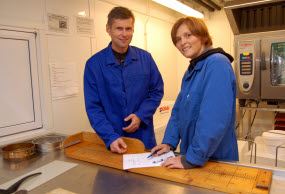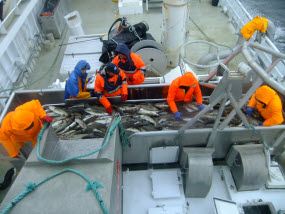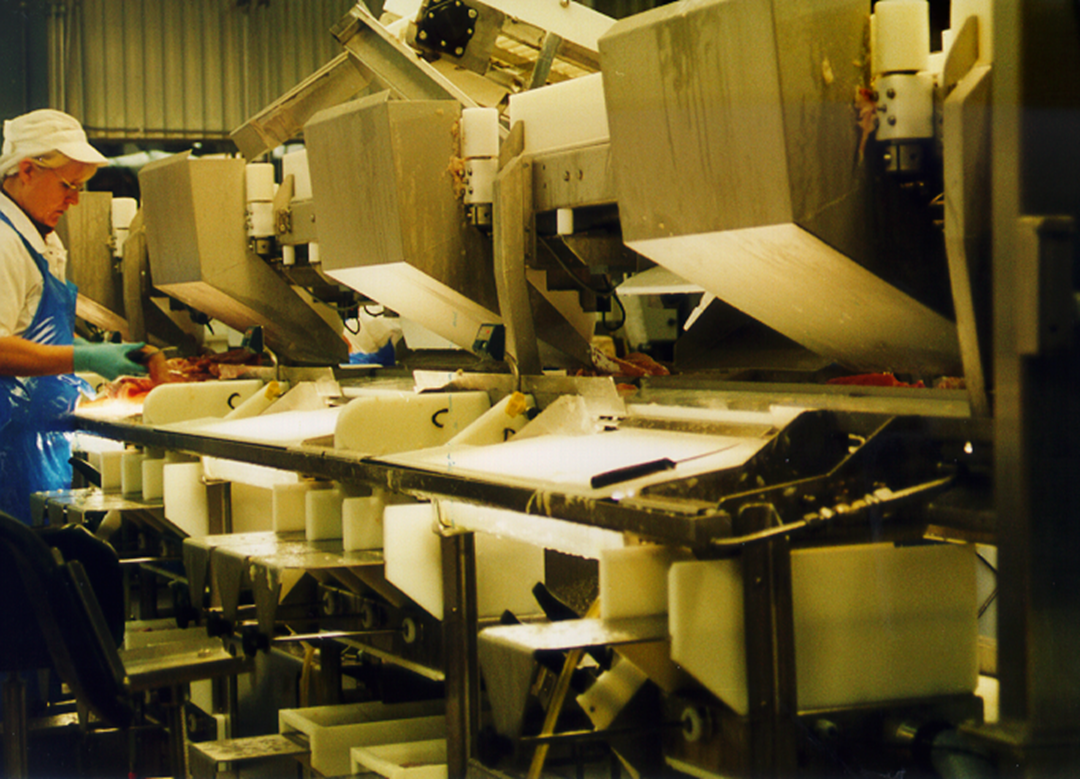White-fish processing employed thousands of people all along the coast of Norway during the first post-war decades. However, the number of filleting plants in the country has sunk drastically – from 100 at the start of the 1970s to only 10 in 2012.
For such filleting plants as do remain, the golden age is also over. Profitability is low, says the SINTEF report, which is based, among other methods, on questionnaires and in-depth interviews with people who are active in the sector.
However, the knowledge garnered by the project also enables SINTEF to conclude that it should be possible to restore the Norwegian filleting industry to profitability.
New technology at sea and ashore
The prerequisite is that Norway invest both in new technology for handling catches on board fishing vessels and in automated production technology in processing plants ashore. Projects in both of these areas are already under way in the country.

|
| SINTEF researchers Leif Grimsmo (left) and Hanne Digre claim that both the land-based and sea sides of the industry will gain if Norway decides to develop a competence- and technology-grounded fish-processing industry based on high-quality raw materials. Photo: Svein Tønseth |
The SINTEF report was drawn up on behalf of Norway’s Ministry of Fisheries and Coastal Affairs.
The background for the report is that, on the one hand:
- Norway is producing increasing quantities of frozen gutted and headless white fish that are sold right out of the country, with the result that much value-adding processing takes place abroad. According to the Norwegian Seafood Council, frozen codfish worth a total of NOK 1.23 billion were exported to China in 2011. This represents an increase of 21 percent on the 2010 figure;
While on the other:
- Returns are low throughout the Norwegian whitefish industyry, with the exception of the salted and dried fish sector.
“Many people have predicted that it is only a matter of time before all of Norway’s fish-filleting plants close,” says SINTEF researcher Leif Grimsmo, one of the report’s two authors. However, he does see some light at the end of the tunnel.
Triple recipe
According to the report, it should be possible to revive a profitable processing industry for on-board frozen white fish in Norway by investing in a triple strategy:
- Market-led production: Norway will have to develop a fish-processing industry that is better capable of supplying high-cost products to well-paying and rapidly growing markets for seafood, such as the sushi market.
- Better-quality raw materials: If the first goal is to be realised, the quality of the on-board frozen raw material will have to be raised on many fishing vessels. This will mean handling the catch differently from current practice, and on-board automatic slaughtering lines will have to be developed.
- Automated processing plants: If whitefish are to be processed on Norwegian soil in the future, the processing plants will also have to be automated. Backbone removal and filleting are currently time-consuming processes, which are difficult to reconcile with high wage levels.

|
| Some vessels in the Norwegian Danish-seiner fleet have begun to implement quality-improvement measures. They sort the fish by quality and species as soon as they come on board, before they are pumped, still alive, into tanks full of water. Photo: SINTEF |
“Great potential”
SINTEF Fisheries and Aquaculture research scientists Leif Grimsmo and Hanne Digre wrote the report.
“We believe that Norway has significant potential for profitable processing of frozen whitefish in an industry based on competence and technology,” they write in their concluding chapter.
The researchers describe the premises on which their conclusions are based in more detail:
On high-price versus low-price markets
Hanne Digre: “Pointing the industry in the direction of high-price quality products is alpha and omega for the revival of Norwegian fish-processing. Our high wage levels mean that we cannot compete with China in a production sector that is oriented towards low-price markets.
“In fact, most of the increased Norwegian exports of frozen whole cod, saithe and haddock last year went to China, which is where these Norwegian raw material were filleted before they were re-exported to the world market as twice-frozen low-price products.”
On raw material quality and slaughter lines
Leif Grimsmo: “In Norway, land and sea are at odds. We have seen claims that trawlers do not earn enough if they are forced to sell “obligatory delivery” fish to Norwegian processing plants, not to mention the crass counter-questions that are asked about whether land-based employment is worth less than sea-going jobs. However, the route to greater Norwegian value-adding is via competence-based processing of high-quality raw material, not via “obligatory delivery” primary materials.
“Some people claim that increasing the availability of high-quality raw materials will mean changing over to a line fishery. This is because line vessels bring fish on board one at a time, with all the potential of that method for maintaining high raw material quality. However, any rational exploitation of our fishery resources means that we also need to use fishing gear such as trawls and Danish seines.
“Trawlers and Danish-seinenetters land large quantities of fish in one go. As long as the catch is handled the way it is today, its quality is bound to be poor. But if we develop sorting routines, buffer storage of live fish on board and automated slaughter technology, it should be quite possible to obtain top-quality raw materials on such vessels too.
On automation aboard
Leif Grimsmo: “Some vessels in the Norwegian Danish-seiner fleet have begun to implement quality-improvement measures. They sort the fish by quality and species as soon as they come on board, before they are pumped, still alive, into tanks full of water. SINTEF is collaborating with Norwegian industry in the development of automatic slaughter lines for Danish-seiners and trawlers. Such lines ensure that the fish are rapidly anaesthetised and bled, and result in faster processing and thus better product quality.
"Three automatic anaesthetising systems have already been installed in the Danish-seiner fleet. Another important effect is that the fishermen can now bleed fish that are lying quietly. If you ask the people who work on these boats, they will tell you that they wouldn’t like to go back to the time when they had to struggle with hundreds of struggling fish, at risk to life and limb.”
On automation ashore
Hanne Digre: "Even though Chinese wage levels have risen by 30 – 40 per cent in the past few years, Norway cannot compete in labour-intensive fish processing. Automatic filleting is essential. Several equipment manufacturers are developing the technology that this requires, although they are not there yet. However, the Fishing and Aquaculture Industry Research Fund has begun a number of major projects in this area, so the industry does believe that this is a problem that can be solved.
On potential gains
Grimsmo and Digre say that the liner fleet gets better prices for its fish than the trawlers, precisely because of differences in the quality of the raw materials they supply. They believe that this offers a pointer to how both the land-based and sea sides of the industry will gain if Norway decides to develop a competence- and technology-grounded fish-processing industry based on high-quality raw materials.
The two scientists point out that such a strategy would also help to maintain Norway’s decentralised pattern of population distribution, a policy that enjoys widespread supportin this country.
By Svein Tønseth

